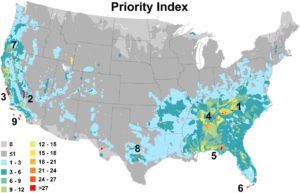Virginia’s Blue Ridge Mountains Recommended as Future Priority Conservation Area

A study in the journal, Proceedings of the National Academy of Sciences of the United States of America, (PNAS) identifies our very own Blue Ridge Mountains as a recommended priority area for future conservation, along with eight other areas. The study also states that much of the protected lands in the U.S. are not aligned with the nation’s conservation priorities. This study, “U.S. protected lands mismatch biodiversity priorities,” was carried out by Clinton N. Jenkins, Kyle S. Van Houtan, Stuart L. Pimm, and Joseph O. Sexton, and can be read at pnas.org/content/112/16/5081.
While the majority of U.S. protected land is in the West, the majority of vulnerable species are in the Southeast. The article shares that the most imperiled groups of vulnerable species are those with small geographic ranges. A species range can be measured by both U.S. and global standards. The species’ level of endemism, or being unique to a defined geographic location, was another important factor in determining their vulnerability. In order to explore and evaluate which areas of the country need to be prioritized for further conservation, the researchers mapped biodiversity by “overlaying range maps for terrestrial vertebrates, freshwater fish, and trees, the taxa for which spatial data were sufficient.” The study found that, “[p]atterns of endemism for all taxa are consistently centered in the Southeast, although the west also has significant mammal endemism.”
Most lands in the east and center of the U.S. are privately owned and unprotected. While conservation easements on private land exist and are still being inventoried, it is clear they are not covering the most “endemic-rich” areas. The >1200 endemic species this study focused on were given priority scores which were, in turn, used to identify geographic areas of recommended conservation priority. The Southeast, California, and Texas were the highest-priority areas identified, specifically: the Blue Ridge Mountains; Sierra Nevada Mountains; California Coast Ranges; Tennessee, Alabama, and northern Georgia watersheds; Florida panhandle; Florida Keys, Klamath Mountains; South-Central Texas around Austin and San Antonio; and Channel Islands of California. A map of the priority areas identified is below.

The authors made specific note that the Blue Ridge Mountains along the Virginia, North Carolina, and Tennessee borders are public lands that are insufficiently protected. Much of this area is National Forest that does not have an International Union for Conservation of Nature (IUCN) rating. The article states that “[r]aising the protection level of these lands, emphasizing ecosystem protection and low-impact recreation over extractive uses, would be a major conservation gain.”
The Blue Ridge Mountains area, which provides a habitat for “substantial biodiversity,” was “recommended for immediate conservation attention.” This study underlines why public and private conservation must focus on biodiversity priorities in Virginia and throughout the U.S.
Wild Virginia is a grassroots, non-profit organization dedicated to preserving Virginia’s national forests through education and advocacy. Click here join our action listserv and stay connected with our work and help protect these special places.
Source:
Biological Sciences – Ecology:
- Clinton N. Jenkins,
- Kyle S. Van Houtan,
- Stuart L. Pimm,
- and Joseph O. Sexton
US protected lands mismatch biodiversity priorities PNAS 2015 112 (16) 5081-5086; published ahead of print April 6, 2015, doi:10.1073/pnas.1418034112